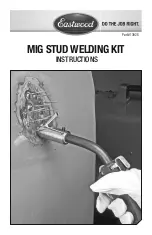
APPLICATION
Stud welding is a method used for removing dents in sheet metal its advantages really stand out
when using on panels where it is not possible to get to the backside where a hammer and dolly will
not work. As with many other repair tasks it will take some practice so it is recommended to test and
hone in your skills on scrap metal or parts from a junk yard before using on your project. To remove a
dent you can follow the following basic steps:
1.
Identify where the dent is located on the panel.
2.
Use either a grinder with a fl ap disc or a DA Sander with 40 Grit paper to remove all of the
paint. If there are deep areas which a disc cannot get into, use a wire brush on an angle grinder
or drill.
3.
Once all of the paint is removed locate the lowest spots of the dent and start by adding pins to
these locations.
4.
Expand out and add more pins to the areas that are not as deep. These shallow areas will
require less pins be welded.
5.
Allow the metal to cool to keep from pulling the pins off the panel.
6.
Slide the pin holder of the slide hammer over the pin and move your fi nger over the locking cam
to make sure the pin is locked onto the hammer.
7.
Pull back on the slide of the hammer with a quick motion to pull the metal back. It may help to
tap the metal around the pin with a body hammer to relax it and allow for the metal to move
easier. When choosing which pins to pull you should start at the outside of the dent and work
towards the center. Ideally the dent should be repaired enough so that the maximum amount of
fi ller used should be 1/16” or less.
8.
If the dent is still not removed enough, go back and add more pins and pull the dent more.
9.
Once the dent has been repaired, the pins can be cut off near the heads and ground down us-
ing a DA Sander or Flap Disc on a Grinder. Do not allow the metal to get to hot when grinding or
it could warp the panel.
10.
Properly clean the surface and apply body fi ller as necessary followed by primer and a top coat.
TROUBLESHOOTING
• When using the slide hammer the pin pulls off the panel.
° If the pin is being pulled off the panel, it is not completely fused. Make adjustments to the
welder and/or the position of the Stud Weld Nozzle.
° Make sure the panel is free of dirt, grease, paint, wax, etc.
• The slide hammer slips off the pin when operating.
° The knurled cam on the slide hammer may be worn out or clogged with copper from the
pins. Either clean out the knurling or replace the knurled cam.
• When lifting the torch off the piece after the welding, the pin lifts up with it.
° Allow the weld puddle to cool before lifting the torch off the pin.
• An excessive weld bead needs to be formed to get the pin to fuse to the panel.
° Adjust the Stud Weld Nozzle so that the wire is in direct contact with the head of the pin.
ACCESSORIES
For accessories and replacement parts, visit Eastwood.com >>
KEYWORD: 13928




